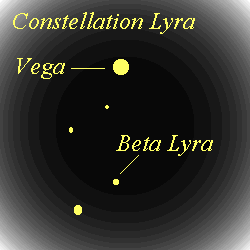
Variable stars are stars that change their brightness, often with a predictable rise and fall. Beta Lyra is one of these stars.

The constellation Lyra is high in the evening skies for most of summer. The bright star Vega is easy to spot as are the four stars forming a parallelogram below it. One of these four stars, Beta Lyra, is an eclipsing binary. Every twelve days the two stars that make up Beta Lyra, complete an orbit around one another, as the larger, darker star passes in front of it's brighter companion we, on earth, notice the star getting dimmer. This is a slow and difficult process to measure.
Using our Astrovid Video camera we captured images of Beta Lyra and, for reference, Vega. The image below shows four images of Beta Lyra (on left) beside an image of Vega (on right) The images were captured on four different nights.
Using a computer we "zoomed" in on these images until we could see the individual pixels that made up the star images. These pictures are a measure of the brightness of these stars.
(Click on the image if you would like to download it and zoom in yourself. You will need a graphics program like Corel Photopaint or Lview to be able to zoom on the image.)
The reason we captured an image of Vega, which does not change in brightness, was so that we could compare the transparency of the atmosphere each night to be sure that Beta Lyra did not look dimmer because some thin clouds had moved in.
To accurately measure the brightness of Beta Lyra we created a computer program to calculate the ratio of the brightness of Beta Lyra to Vega . This method allows for any variation caused by the atmosphere.
If you would like a copy of the program, starlite.exe, with instructions and images to work with click here: starlite